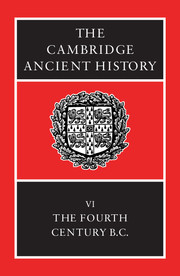Book contents
- Frontmatter
- 1 Sources and their uses
- 2 Sparta as victor
- 3 Persia
- 4 The Corinthian War
- 5 Sicily, 413–368 B.C.
- 6 The King's Peace and the Second Athenian Confederacy
- 7 Thebes in the 360s B.C.
- 8 Regional surveys I: Persian lands and neighbours
- 9 Regional surveys II: the West and North
- 10 Society and economy
- 11 The polis and the alternatives
- 12 Greek culture and science
- 12a The Growth of Schools and the Advance of Knowledge
- 12b Medicine
- 12c Greek art: Classical to Hellenistic
- 12d Greek agriculture in the classical period
- 12e Warfare
- 13 Dion and Timoleon
- 14 Macedon and north-west Greece
- 15 Macedonian hegemony created
- 16 Alexander the Great Part 1: The events of the reign
- 17 Alexander the Great Part 2: Greece and the conquered territories
- 18 Epilogue
- Chronological Table
- BIBLIOGRAPHY
- Index
- Map 1: Greece and Western Asia Minor
- Map 9: Egypt
- Map 20: Alexanders campaigns
- References
12c - Greek art: Classical to Hellenistic
from 12 - Greek culture and science
Published online by Cambridge University Press: 28 March 2008
- Frontmatter
- 1 Sources and their uses
- 2 Sparta as victor
- 3 Persia
- 4 The Corinthian War
- 5 Sicily, 413–368 B.C.
- 6 The King's Peace and the Second Athenian Confederacy
- 7 Thebes in the 360s B.C.
- 8 Regional surveys I: Persian lands and neighbours
- 9 Regional surveys II: the West and North
- 10 Society and economy
- 11 The polis and the alternatives
- 12 Greek culture and science
- 12a The Growth of Schools and the Advance of Knowledge
- 12b Medicine
- 12c Greek art: Classical to Hellenistic
- 12d Greek agriculture in the classical period
- 12e Warfare
- 13 Dion and Timoleon
- 14 Macedon and north-west Greece
- 15 Macedonian hegemony created
- 16 Alexander the Great Part 1: The events of the reign
- 17 Alexander the Great Part 2: Greece and the conquered territories
- 18 Epilogue
- Chronological Table
- BIBLIOGRAPHY
- Index
- Map 1: Greece and Western Asia Minor
- Map 9: Egypt
- Map 20: Alexanders campaigns
- References
Summary
STYLE AND ICONOLOGY
Greek art in the fourth century B.C. is made up of two distinct strands – one, an external set of stylistic mannerisms derived from the art of the fifth century B.C. and the other, an inner spirit that anticipates the art of the hellenistic period – and it is these two strands, woven together, that give the monuments of the period their particular character.
Greek sculptors of the fourth century, for example, frequently adopted the elegant, calligraphic style of Attic art of the later fifth century as their point of departure. At other times they reached back beyond this style to the serene and balanced style of the Parthenon frieze or to the formal harmony of Polyclitus. These prototypical styles were further developed, naturally, in ways that make works of the fourth century recognizable and distinctive, but a sense of formal continuity with the past nevertheless always remains strong in them. On the basis of certain votive reliefs and grave stelae, in fact, it can even be argued that neoclassicism, that reverence at a distance for the art of the high Classical period as a moment of perfection which can only be emulated because it cannot be surpassed, had its origin in the fourth century. On the other hand, if one looks at the content of fourth-century sculpture, at the attitudes and feelings that it is used to express, one finds a new interest in the personal experience of the individual as an appropriate subject for the visual arts and, with it, a rejection of the more impersonal, group-oriented themes connected with the life of the polis that had been the concern of much of the art of the fifth century.
- Type
- Chapter
- Information
- The Cambridge Ancient History , pp. 647 - 660Publisher: Cambridge University PressPrint publication year: 1994

